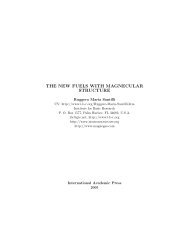hadronic mathematics, mechanics and chemistry - Institute for Basic ...
hadronic mathematics, mechanics and chemistry - Institute for Basic ...
hadronic mathematics, mechanics and chemistry - Institute for Basic ...
You also want an ePaper? Increase the reach of your titles
YUMPU automatically turns print PDFs into web optimized ePapers that Google loves.
HADRONIC MATHEMATICS, MECHANICS AND CHEMISTRY 13<br />
the system. The quantization of such a Hamiltonian then leads to a plethora of<br />
illusions, such as the belief that the uncertainty principle <strong>for</strong> energy <strong>and</strong> time<br />
is still valid while, <strong>for</strong> the example here considered, such a belief has no sense<br />
because H does not represent the energy (see Refs. [9b] <strong>for</strong> more details).<br />
Under the strict adoption of Assumption 1.2.1, all these ambiguities are absent<br />
because H will always represent the energy, irrespective of whether conserved or<br />
nonconserved, thus setting up solid foundations <strong>for</strong> correct physical interpretations.<br />
1.2.3 General Inapplicability of Conventional<br />
Mathematical <strong>and</strong> Physical Methods <strong>for</strong> Interior<br />
Dynamical Systems<br />
The impossibility of reducing interior dynamical systems to an exterior <strong>for</strong>m<br />
within the fixed reference frame of the observer causes the loss <strong>for</strong> interior dynamical<br />
systems of all conventional mathematical <strong>and</strong> physical methods of the<br />
20-th century.<br />
To begin, the presence of irreducible nonselfadjoint external terms in the analytic<br />
equations causes the loss of their derivability from a variational principle.<br />
In turn, the lack of an action principle <strong>and</strong> related Hamilton-Jacobi equations<br />
causes the lack of any possible quantization, thus illustrating the reasons why<br />
the voluminous literature in quantum <strong>mechanics</strong> of the 20-th century carefully<br />
avoids the treatment of analytic equations with external terms.<br />
By contrast, one of the central objectives of this monograph is to review the<br />
studies that have permitted the achievement of a re<strong>for</strong>mulation of Eqs. (1.2.3)<br />
fully derivable from a variational principle in con<strong>for</strong>mity with Assumption 1.2.1,<br />
thus permitting a consistent operator version of Eqs. (1.2.3) as a covering of<br />
conventional quantum <strong>for</strong>mulations.<br />
Recall that Lie algebras are at the foundations of all classical <strong>and</strong> quantum<br />
theories of the 20-th century. This is due to the fact that the brackets of the time<br />
evolution as characterized by Hamilton’s equations,<br />
dA<br />
dt = ∂A<br />
∂r k a<br />
= ∂A<br />
∂r k a<br />
× drk a<br />
dt + ∂A × dp ak<br />
∂p ak dt<br />
× ∂H<br />
∂p ak<br />
− ∂H<br />
∂r k a<br />
=<br />
× ∂A<br />
∂p ak<br />
= [A, H], (1.2.6)<br />
firstly, verify the conditions to characterize an algebra as currently understood<br />
in <strong>mathematics</strong>, that is, the brackets [A, H] verify the right <strong>and</strong> left scalar <strong>and</strong><br />
distributive laws,<br />
[n × A, H] = n × [A, H], (1.2.7a)<br />
[A, n × H] = [A, H] × n,<br />
(1.2.7b)














